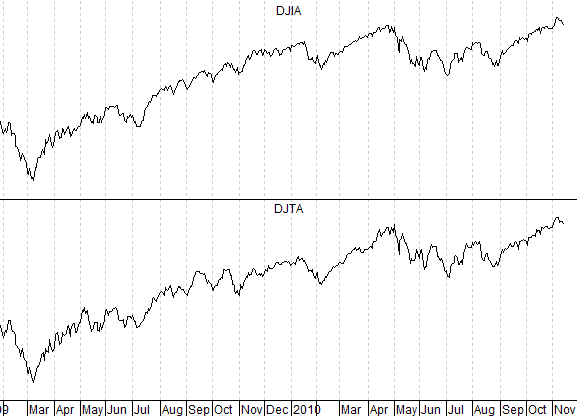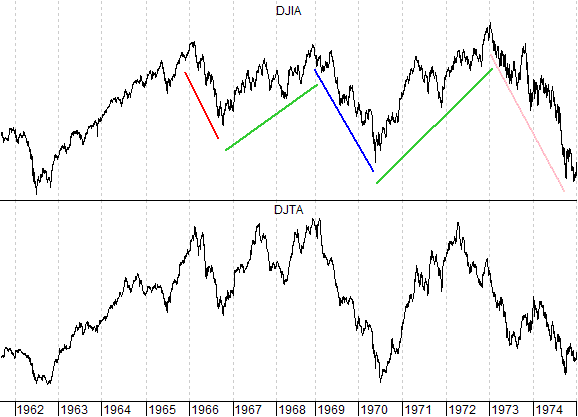Stock Market Dow Theory Update
Stock-Markets / Stocks Bear Market Nov 13, 2010 - 04:27 PM GMTBy: Tim_Wood
 When it comes to Dow theory, there seems to be no shortage of opinion, but most often, that opinion is wrong. This is largely because of the fact that very few people have actually read and studied the original material by Charles H. Dow, William Peter Hamilton and Robert Rhea. Without that background, one cannot truly understand Dow theory.
When it comes to Dow theory, there seems to be no shortage of opinion, but most often, that opinion is wrong. This is largely because of the fact that very few people have actually read and studied the original material by Charles H. Dow, William Peter Hamilton and Robert Rhea. Without that background, one cannot truly understand Dow theory.
Of late I have been asked whether or not the bettering of the April highs triggered a so-called “Dow theory buy signal.” Before I answer this question, it deserves a full explanation.
First let me say that in accordance with orthodox Dow theory, there is no “buy” or “sell” signal. That’s right. Contrary to popular belief, there is no such thing. The Dow theory founding fathers would anticipate trend changes just like we do. They would use minor negative non-confirmations and negative structural developments that hinted of a trend change as “Sell Spots.” At bottoms they would do the exact opposite using minor positive non-confirmations and positive structural developments that hinted of an upward trend reversal as “Buy Spots.”
They then looked for the Industrials and what was then the Rails, to close above their previous “Secondary High Point” in the case of a bottom, or the previous “Secondary Low Point” in the case of a top, in order to confirm that a “Primary Trend Change” had occurred. It is clear from reading the original writings that they did not wait for these Primary Trend Changes to occur before establishing positions. The problem with the interpretation today is that people do not understand what constitutes a secondary high or low point and they erroneously interpret moves above and below what is perceived as a secondary high or low point to be a “Dow theory Buy or Sell signal.” Fact is, there is no such thing as a “Dow theory Buy or Sell signal.” According to the original writings, there were Buy and Sell Spots, which were based on minor structural developments, in anticipation of turns and there are Primary Trend changes.
Now, I want to discuss the current situation with Dow theory. Fact is, the most recent Secondary low point occurred at the July low. Please refer to the first chart below. In typical fashion, most everyone was calling the move into early July a “Dow theory sell signal” because of the move below the May and June lows, which were erroneously perceived as having marked the previous Secondary Low Point. I explained to my subscribers as price was moving down into the July low that this was NOT a “sell signal” nor was it a Dow theory Primary Trend change and that price was in fact making a Secondary Low Point.
As price moved out of that low it bettered the June high and I then received questions as to whether or not a “buy signal” had occurred. The same was also true when the August high was bettered. Now that the April high has been bettered I’m seeing the same thing. The best way to stay abreast of the Dow theory developments in real time and even to know ahead of time what we are expecting and what a particular move means is through my monthly research letter and short-term updates. Anyway, the bettering of the April high merely served to reconfirm the already existing bullish Primary Trend change, which has been intact in association with the upturn out of the March 2009 low, for well over a year now.

I have stated in every article posted here since the rally out of the March 2009 low began that this is a bear market rally. I have stated here in every article since the bullish Primary Trend change in July 2009 occurred that the Primary Trend in accordance with Dow theory has been bullish. That has not changed. I have also stated here, ever since the rally out of the 2009 low began, that, based on the phasing aspects of Dow theory, this rally should ultimately prove to be the rally separating Phase I from Phase II of a much longer-term secular bear market. This view has not changed either. So, to clarify, on one hand we have had and continue to have a bullish Primary Trend in accordance with Dow theory and the bettering of the April high only reconfirmed the existence of that trend. But, in the bigger picture, the Dow theory phasing tells us that this rally is in all likelihood a bear market rally within a much longer-term secular bear market.
I have included a chart below of the 1966 to 1974 bear market period. The decline into the Phase I low is noted in red. The bear market rally that separated Phase I from Phase II is noted in green and carried the averages up for some 26 months into that top. In the process of this advance, a Dow theory bullish Primary Trend change occurred, just as we have seen with the current advance. But, ultimately the phasing proved correct and the Phase II decline carried the averages to new lows. Those that understood the value and phasing aspect of Dow theory would have understood what was occurring.

Then, from the Phase II low, the averages advance some 32 months. This rally was also a bear market rally separating Phase II from Phase III of the bear market and this time around the Industrials were able to move to a new all time high. In the process there was of course, another Dow theory bullish Primary Trend change. However, the phasing aspect of Dow theory was again correct and once this rally ran it course, the averages again headed lower. Note that this decline carried the Industrials to new lows, but not the Transports. As a result, a Dow theory non-confirmation occurred in conjunction with the Phase III low and great values.
So, the moral of the story is that the bettering of the April high was not a so-called “Dow theory Buy signal.” In reality it only served to reconfirm the existing bullish Primary Trend change. Also, I continue to believe that we are in a similar pattern to that of the 1966 to 1974 period. I believe that the rally out of the 2009 low is synonymous with the advance out of the 1966 low. One difference now is that the bull market period that preceded the 1966 top was only 24 years and the bear market period ran 8 years, which was the historical one-third the duration of the preceding bull market. In this case, the preceding bull market ran 33 years. Therefore, we should be dealing with a bear market of approximately 11 years. So, the unwinding of this bear market should have much further to go. Perhaps, QEII will keep this rally going a while longer. But, I don’t think that QEII or QEIII or even QEIV will ever be able to ultimately save the market from the natural forces. All these efforts are doing are making matter worse and if anything, postponing the inevitable.
I have begun doing free market commentary that is available at www.cyclesman.info/Articles.htm The specifics on Dow theory, my statistics, model expectations, and timing are available through a subscription to Cycles News & Views and the short-term updates. I have gone back to the inception of the Dow Jones Industrial Average in 1896 and identified the common traits associated with all major market tops. Thus, I know with a high degree of probability what this bear market rally top will look like and how to identify it. These details are covered in the monthly research letters as it unfolds. I also provide important turn point analysis using the unique Cycle Turn Indicator on the stock market, the dollar, bonds, gold, silver, oil, gasoline, the XAU and more. A subscription includes access to the monthly issues of Cycles News & Views covering the Dow theory, and very detailed statistical based analysis plus updates 3 times a week.
By Tim Wood
Cyclesman.com
© 2010 Cycles News & Views; All Rights Reserved
Tim Wood specialises in Dow Theory and Cycles Analysis - Should you be interested in analysis that provides intermediate-term turn points utilizing the Cycle Turn Indicator as well as coverage on the Dow theory, other price quantification methods and all the statistical data surrounding the 4-year cycle, then please visit www.cyclesman.com for more details. A subscription includes access to the monthly issues of Cycles News & Views covering the stock market, the dollar, bonds and gold. I also cover other areas of interest at important turn points such as gasoline, oil, silver, the XAU and recently I have even covered corn. I also provide updates 3 times a week plus additional weekend updates on the Cycle Turn Indicator on most all areas of concern. I also give specific expectations for turn points of the short, intermediate and longer-term cycles based on historical quantification.
Tim Wood Archive |
© 2005-2022 http://www.MarketOracle.co.uk - The Market Oracle is a FREE Daily Financial Markets Analysis & Forecasting online publication.



